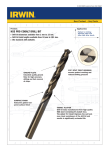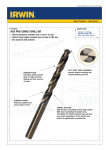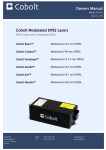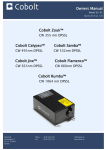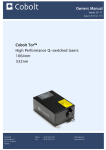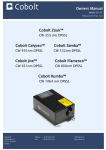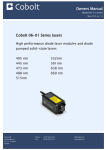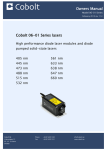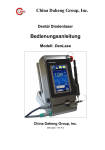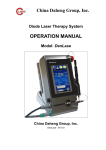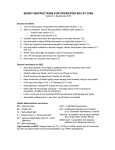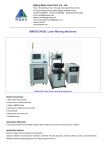Download Owners Manual
Transcript
Owners Manual Model 04-01 April rev 1.51 Cobolt Twist™ Cobolt BluesTM CW 457 nm DPSSL CW 473 nm DPSSL Cobolt Calypso™ Cobolt Fandango™ CW 491nm DPSSL CW 514.4 nm DPSSL Cobolt Samba™ Cobolt Jive™ CW 532 nm DPSSL CW 561 nm DPSSL Cobolt Mambo™ Cobolt Dual Calypso™ CW 594 nm DPSSL CW 491 + 532 nm DPSSL Cobolt Rumba™ CW 1064 nm DPSSL Cobolt AB Phone: +46 8 54591230 [email protected] Vretenvägen 13 Fax: +46 8 54591231 www.cobolt.se SE-171 54 Solna Sweden 1. Introduction ......................................................................................................................................... 5 2. Safety .................................................................................................................................................. 6 2.1. General.................................................................................................................................................. 6 2.2. Safety Features ...................................................................................................................................... 7 2.3. 3. Warning labels and Identification ........................................................................................................... 8 Laser System Description ...................................................................................................................... 9 3.1. Model Number....................................................................................................................................... 9 3.2. Laser Head .......................................................................................................................................... 10 3.2.1. 3.3. Versions..................................................................................................................................... 10 Controller ............................................................................................................................................ 10 3.3.1. Controller Configuration ............................................................................................................ 11 3.4. Cable ................................................................................................................................................... 11 3.5. Power supply requirements ................................................................................................................. 11 3.6. 4. Thermal Management .......................................................................................................................... 12 System Description ............................................................................................................................. 13 4.1. Specifications ...................................................................................................................................... 13 4.1.1. Optical ....................................................................................................................................... 13 4.1.2. Operational and environmental requirements ............................................................................ 14 4.1.3. Electrical interfaces .................................................................................................................... 14 4.1.4. Mechanical Interfaces ................................................................................................................. 15 4.2. Mechanical outlines ............................................................................................................................. 15 4.3. Connector drawings & pin assignment................................................................................................. 17 4.3.1. Analog connector & interlock connector..................................................................................... 17 4.3.2. Power connector ........................................................................................................................ 17 4.3.3. 4.4. 4.5. 5. Data connector .......................................................................................................................... 17 Interlock .............................................................................................................................................. 18 Direct On/Off ...................................................................................................................................... 18 Operation instructions ........................................................................................................................ 19 5.1. 5.2. 6. Installation start-up operation............................................................................................................. 19 Closedown operation ........................................................................................................................... 19 Operation via data port ....................................................................................................................... 20 6.1. Baud rates and serial port settings ...................................................................................................... 20 6.2. Handshaking ....................................................................................................................................... 20 6.3. 7. Control commands .............................................................................................................................. 20 Cobolt Monitor software ..................................................................................................................... 22 7.1. 7.2. Installation .......................................................................................................................................... 22 Software instructions ........................................................................................................................... 22 8. Fiber pigtailed Option: Cobolt 04-03 ................................................................................................... 24 9. Troubleshooting ................................................................................................................................. 24 10. Warranty and maintenance .................................................................................................................. 25 11. Service ............................................................................................................................................... 25 12. Declaration of conformity (CDRH model only) ....................................................................................... 26 13. Disclaimers ........................................................................................................................................ 27 4 Cobolt TwistTM BluesTM CalypsoTM Dual CalypsoTM FandangoTM SambaTM JiveTM MamboTM RumbaTM 5 Cobolt TwistTM BluesTM CalypsoTM Dual CalypsoTM FandangoTM SambaTM JiveTM MamboTM RumbaTM 1. Introduction Cobolt 04-01 Series lasers are continuous-wave diode-pumped solid-state laser devices operating at fixed wavelengths as defined in the specifications in Section 4. The laser beam is collimated and emitted through the manual shutter of the laser head. The laser head contains elements for fine temperature control of the laser cavity as well as the pump diode. The laser also features an optical feed-back loop which ensures long-term power stability of the emitted laser beam. The system can be operated in constant current or constant power mode. Control signals and drive currents are supplied via an electrical interface. The lasers have a compact hermetically sealed package and emit a high quality beam with stable characteristics over a wide range of operating conditions. The laser is designed and manufactured to ensure a high level of reliability. Cobolt lasers are intended for stand-alone use in laboratory environment or for integration in analytical equipment used in e.g. flow cytometry, DNA sequencing, fluorescence microscopy, holography, interferometry and Raman spectroscopy. 6 Cobolt TwistTM BluesTM CalypsoTM Dual CalypsoTM FandangoTM SambaTM JiveTM MamboTM RumbaTM 2. Safety 2.1. General All Cobolt 04-01 Series lasers are Class IIIB (CDRH), Class 3B (IEC) laser products that emit less than 500 mW of laser radiation within the visible and near-infrared spectrum. Residual emissions from the pump diode are contained within the laser head housing via filtering optics. The residual emission does not exceed Laser Class 1. Eye and skin exposure to direct or reflected laser light is hazardous and may be extremely harmful. Always wear eye protection appropriate to the beam wavelength and intensity. The device must be handled by personnel with experience in laser operation, in a laboratory environment and with access to adequate laser safety equipment. The Laser Head clearly displays a yellow warning label that shows the location of the laser beam aperture. This label must be visible unless the laser beam is totally enclosed, see section 2.3 for more information on labeling. The table below described the maximum irradiance in W/cm2 and appropriate level of eye protection in terms of optical density (OD) for each product line. Product Output power (mW) Irradiance [W/cm2]* Eye Protection Requirement** Twist™ 457nm 50 19 > OD 4 Blues™ 473nm 50 19 > OD 4 100 39 > OD 4 50+50 mW 39 > OD 4 Fandango™ 514.4nm 150 58 > OD 4 Samba™ 532nm 300 117 > OD 4 Jive™ 561nm 150 58 > OD 4 Mambo™ 594nm 100 39 > OD 4 Rumba™ 1064nm 400 64 > OD 3 Calypso™ 491nm Dual Calypso™ 491nm+532nm * Irradiance (W/cm2) = 110% of Nominal Power (W) ÷ Beam Area at bottom tolerance (cm2) ** Eye protection (OD) = Log10( 60825-1 Emission Limit : Class 1 (W) Max Power (W) ) , rounded up to the next integer. 2.1.1. 2.1.1 Fiber pigtailed 04-03 Based on 60825-1 Laser Safety standard the accessible emission from any laser must be considered at a viewing distance of 100mm. At that distance the beam diameter of a divergent beam exiting from a fiber pigtailed laser will always be greater than the ‘Beam Area at bottom tolerance (cm2)’ of the collimated beam used in the calculations above, therefore the irradiance (W/cm2) will also be lower. CAUTION - use of controls or adjustments or performance of procedures other than those specified herein may result in hazardous radiation exposure. 7 Cobolt TwistTM BluesTM CalypsoTM Dual CalypsoTM FandangoTM SambaTM JiveTM MamboTM RumbaTM 2.2. Safety Features Interlock The laser is equipped with a remote interlock that prevents current flowing through the diode when it is open. See section 4.4 for a detailed description of the interlock. Mechanical shutter The Laser Head is equipped with a mechanical shutter that blocks all laser emission. The open and closed positions of the shutter are indicated on the Laser Head. Key switch The CDRH model comes with a key switch on the controller that must be turned for the laser to operate. When the key is off, the diode is prevented from emitting. The key must be actively turned to the ON position each time the laser is powered on. Information LEDs The Controller incorporates information LEDs which display whether power is connected, the laser is on, or a fault has occurred. The “ON” LED is illuminated whenever the device is emitting or could emit light. 8 Cobolt TwistTM BluesTM CalypsoTM Dual CalypsoTM FandangoTM SambaTM JiveTM MamboTM RumbaTM 2.3. Warning labels and Identification The upper face of the Laser Head contains a yellow label with laser safety warning and classification information, the wavelength and maximum average power of the unit. The laser safety label also shows the location of the laser beam from the aperture and indicates the open and closed positions of the manual shutter. This label must be visible unless the laser beam is totally enclosed. The Laser Head and Controller are provided with a manufacturer’s identification label including a serial number which is unique for each laser system. Placement of labels: Hazard Symbol and Aperture Label Manufacturers Certification label CDRH models shipped to USA 9 Cobolt TwistTM BluesTM CalypsoTM Dual CalypsoTM FandangoTM SambaTM JiveTM MamboTM RumbaTM 3. Laser System Description The Cobolt 04-01 Series laser systems consist of four main parts: the Laser Head, the Controller, the Cable and the Power Supply. The Cable should always be used to connect the Laser Head with the Controller. Always install the laser system to a properly grounded power outlet. Cobolt lasers contain a laser diode which is sensitive to electrostatic discharge (ESD). The device must be handled in an ESD protected workstation. Controller Cable Laser Head Cobolt 04-01 laser system with standard Laser Head 3.1. Model Number The model number is composed as follows for the Cobolt 04 series DPSS lasers: XXXX – 04 – XX – XXXX – XXX Wavelength Version Power Controller Configuration: 300/500 = Gen 4/Gen 5, CDRH Compliant 400/600 = Gen4/Gen 5, OEM Integration Only 10 Cobolt TwistTM BluesTM CalypsoTM Dual CalypsoTM FandangoTM SambaTM JiveTM MamboTM RumbaTM 3.2. Laser Head The Laser Head contains pump diode, laser cavity, beam shaping optics and thermoelectric coolers (TEC). The laser head contains an optical feed-back loop which measures the output power. The Laser Head gets electrical power and control signals from the Controller via a 26-pin HD Sub-D cable. 3.2.1. Versions Free Beam Laser Head 04-01 The standard 04-01 Series laser Head. This model is available with all CDRH and OEM controller configurations. Free Beam Laser Head 04-51 Cobolt lasers with version 04-51, are compact versions of the 05-01 series. This model is only available with configuration -500 and 600, Gen 5 controllers, both CDRH and OEM configurations. Currently only Cobolt Rumba™ 1064nm is available in version 04-51. Fiber Pigtailed Laser Head 04-03 Cobolt 04-01 Series lasers are offered with the option permanently aligned fiber pigtail option. See section 8 : Fiber pigtailed Option: Cobolt 04-03 for details. See http://www.cobolt.se/coboltfiberpigtailedlasers.html for data sheet. 3.3. Controller The Controller supplies driving current and control signals to the Laser Head. All Laser Heads are delivered with a generation 4 or generation 5 controller. The operation set points are specific to each Laser Head and have been fixed during manufacturing. Laser systems delivered Generation 4 Controller have the operation set points stored in the controller and must be used with the appropriate laser head. Systems delivered with Generation 5 controllers have the operation set points stored in the laser head so the controller can be interchanged or replaced. The status of the laser operation is given via LED indicators: POW (green light) Power is supplied. ON (orange light) Laser light is on in constant current mode. LOCK (orange light) Laser light is on and the output power has been locked to set point. The laser is operating according to specifications. ERR (red light) An error has occurred. No laser light. When power is supplied to the Controller, regardless of on/off state, the temperature control elements are operating to reach set point values. The Controller includes a remote interlock connector, pin 1-2 according to Section 4.4. To make use of the remote interlock as a safety switch, remove the jumper and connect to an external switch. 11 Cobolt TwistTM BluesTM CalypsoTM Dual CalypsoTM FandangoTM SambaTM JiveTM MamboTM RumbaTM 3.3.1. Controller Configuration Cobolt 04 Series lasers are available with several standard controller configurations. Table below can be used to choose the model number for the desired controller configuration. The operation of the laser can be controlled and monitored via the data port that supports RS-232 commands and analog signals. See Section 6.3 for further details. RS-232 controllers may also be delivered with a RS-232 to USB adaptor. Controller Gen 4 Gen 5 RS-232 RS -232 OEM -400 -600 CDRH -300 -500 Model Data Connection CDRH Controller A key is supplied to be used to turn on the laser. The laser will be running according to specifications in <2 min. The status of operation is monitored via LED signals. Setting the turn key to its OFF-position puts the laser in stand-by mode. OEM Controller The Controller is factory set so that no key is needed to turn the laser on. Connecting 11-28 VDC power supply to the Controller initiates an automatic start-up sequence. The laser will be running according to specifications in <2 min. 3.4. Cable The Cable connects the Laser Head to the Controller. The standard Cable length is 1 m and minimum bending radius 2 cm. When connected care should be taken not to bend or break any of the 26 pins. 3.5. Power supply requirements An appropriate Power Supply Unit (PSU) is supplied by Cobolt with the laser and must be plugged into a properly grounded standard power outlet. The output from this PSU is 12 VDC/3.75 A. The power supply accepts 90 – 264 VAC and 47-663 Hz. Ripple and noise 1% peak-peak max, 20 MHz bandwidth. The accepted voltage range is 11 V 28 VDC. 12 Cobolt TwistTM BluesTM CalypsoTM Dual CalypsoTM FandangoTM SambaTM JiveTM MamboTM RumbaTM 3.6. Thermal Management To ensure operation within given specifications and for the warranty to be valid, the Laser Head must be attached to a heat sink providing a thermal resistance of <0.5 K/W. This value is the difference between the maximum allowed Laser Head base plate temperature (50ºC) and the maximum specified ambient temperature at the air-heatsink interface (40ºC), divided by the maximum power dissipated from the laser (~20 W for the highest power models at high ambient temperatures). The mounting surface should be flat within 0.05 mm over mounting surface. It is recommended to use a thermal heat compound between the Laser Head and the heat sink to provide good thermal contact. For assistance in thermal management and system integration, please contact Cobolt’s technical support. Heat Sink Requirements and typical maximum heat dissipation for Cobolt 04-01 Series 13 Cobolt TwistTM BluesTM CalypsoTM Dual CalypsoTM FandangoTM SambaTM JiveTM MamboTM RumbaTM 4. System Description 4.1. Specifications 4.1.1. Optical Centre wavelength (nm)1 Output power (mW) Twist™ 457.0 ± 0.3 25 and 50 Blues™ 473.0 ± 0.3 25 and 50 Calypso™ 491.5 ± 0.3 25, 50, 75, 100 Dual Calypso™ 491.5±0.3 + 532.1 ± 0.3 20+20, 50+50 Fandango™ 514.4 ± 0.3 25, 50, 100, 150 Samba™ 532.1 ± 0.3 25, 50, 100, 150, 300 Jive™ 561.2 ± 0.3 25, 50, 75, 100, 150 Mambo™ 593.6 ± 0.3 25, 50, 100 Rumba™ 1064.2 ± 0.6 400 Product Wavelength 457 473 491 Beam diameter at Aperture (µm, 1/e2) Noise 20 Hz – 20 MHz (rms) Long-term power stability (8 hours) Spatial mode Spectral linewidth Wavelength stability (after warm-up) Beam symmetry at aperture Beam pointing stability (after warm-up) 514 532 1.2 1.3 1.6 <3% <5% <2% <3% <2 % <0.25% <0.3% <0.5% <0.25% <0.3% <0.25% <2% <3% <5% <2% <3% <2% TEM00, M2 <1.1 < 1.2 <1 MHz 2 pm over ± 2 ºC and 8 hrs >0.95 : 1 <10 µrad/ºC (over 10-40ºC) Beam waist location (from exit window) 20 cm Beam angle accuracy3 <5 mrad Residual IR emission 1064 <2% >100 m Polarization ratio (linear, vertical) 594 1000 ± 50 Coherence length Beam position accuracy3 561 700 ± 50 Beam divergence (mrad, full angle, 1/e2) Noise 20 Hz – 20 MHz (pk-pk) 491+532 2 <0.25 mm >100:1 <0.1 mW 1. The wavelength is fixed with this accuracy, while drift is defined as Wavelength stability. The wavelength is specified in air. 2. The output power can be adjusted from 10-110% of nominal power using control commands, see Section 6.3. Specifications are guaranteed at 100% of nominal power. Recommended power range is 70-100%. Power accuracy 5%. 3. Relative to beam position reference pins, see Laser Head drawing under Section 4.2. Dual Calypso beam collinearity <250 µrad. 14 Cobolt TwistTM BluesTM CalypsoTM Dual CalypsoTM FandangoTM SambaTM JiveTM MamboTM RumbaTM 4.1.2. Operational and environmental requirements Power supply Power 12 VDC, 3.75 A (11-28 VDC accepted) consumption, total system (Laser Head Controller) + <25 W (typical ~15 W) < 35 W (typical ~25 W):Calypso 100 mW, Samba 300 mW, Mambo 100mW, Rumba 400 mW Maximum heat dissipation of Laser Head <15 W (typical ~10 W) < 20 W (typical ~15 W):Calypso 100 mW, Samba 300 mW, Mambo 100mW, Rumba 400 mW Maximum Laser Head baseplate temperature 50ºC Warm-up time, from OFF <2 min Ambient temperature, operation 10-40ºC Ambient temperature, storage 0-60ºC Humidity 0-90% RH non-condensing Ambient Air pressure 950-1050 mbar Shock tolerance, operational 60 g (8 ms impact) Heat sink thermal resistance, Laser Head <0.5 K/W 4.1.3. Electrical interfaces Interfaces Connector Function Input power Kycon KPJX-45, 4-pin Power supply to Controller Laser Head to Controller HD-sub 26-pin, male Connection to Laser Head Controller to Laser Head HD-sub 26-pin, female Connection to Controller Data port USB-type mini B Control and monitoring via control commands Remote interlock & Molex 90130-3206 Analog input 5 – 12 V => laser on Analog signals Analog input <2.7 V => laser off Warm-up time 2 min 15 Cobolt TwistTM BluesTM CalypsoTM Dual CalypsoTM FandangoTM SambaTM JiveTM MamboTM RumbaTM 4.1.4. Mechanical Interfaces Dimensions: Laser Head 103x60x40 mm (4.1x2.4x1.6 inches) Controller 190x72x28 mm (7.6x2.9x1.1 inches) PSU 130x55x30 mm (5.2x2.2x1.2 inches) Fixation holes, Laser Head 4.5mm hole (fitting M4 or M3), see outline in section 4.2. Fixation holes, Controller 6.4x8mm hole (fitting M6), see outline in section 4.2. Cable (Laser Head – Controller) 1 m length, >2 cm bending radius The information presented here is believed to be accurate and is subject to change without notice. The specifications contained herein cannot be guaranteed outside of normal operational conditions. 4.2. Mechanical outlines The mechanical outline below is the 04-01 and 04-51 laser heads. Mechanical outlines of 04-03 laser heads can be found in section 8. Beam reference points Laser Head mechanical outline model 04-01 and 04-51Standard Laser Head (dimensions in mm and inch). 16 Cobolt TwistTM BluesTM CalypsoTM Dual CalypsoTM FandangoTM SambaTM JiveTM MamboTM RumbaTM Analog & interlock connector Data connector Power connector Controller mechanical outline. Dimensions in mm [inches]. 17 Cobolt TwistTM BluesTM CalypsoTM Dual CalypsoTM FandangoTM SambaTM JiveTM MamboTM RumbaTM 4.3. Connector drawings & pin assignment 4.3.1. Analog connector & interlock connector Manufacturer Molex 90130-3206, mates with 90142-0006. Pin Function 1. Interlock (connect to pin 2 for enable) 2. GND 3. Analog on/off (Direct on/off control) 4. TST (Internal Cobolt use only) 5. LED “Laser on” (5V) 6. LED “Error” (5V) 1 3 5 2 4 6 Warning: shortening pins 2 and 4, when the controller is powered up, will erase the controller memory. 4.3.2. Power connector Kycon KPJX-4S, mates with Kycon KPPX-4P. Grounded shield. Pin Function 1. 0V 2. +11-28 VDC 3. 0V 4. +11-28 VDC Front view of controller 4.3.3. Data connector Connector USB-type, manufacturer Hsuan Mao C8320-05BFDSB0, mates with connector mini-B. Pin Function 1. +5 V (in series with internal 10 Ohm resistor) 2. RS-232_TX 3. RS-232_RX 4. Not connected 5. 0 V (GND) 18 Cobolt TwistTM BluesTM CalypsoTM Dual CalypsoTM FandangoTM SambaTM JiveTM MamboTM RumbaTM 4.4. Interlock The interlock is located at pin 1 and 2 of the molex connector on the back side of the laser head. The connector can be short-circuited with an interlock jumper (included at delivery) for operation of the laser. To use the interlock with an external switch, connect a pin 1 and 2 on a Molex plug. After the interlock has been opened the laser will need to be reset by disconnecting from and then reconnecting to the power supply in order to start again. Alternatively, it can be re-started using a special sequence of RS-232 commands, see Section 6.3 for further details. The signal level is between 0V and +5V with a pull up resistor (R225/R224), and the current required to ground the interlock is 5 mA. The time delay in the hardware is <1ms, but after filtering by the firmware the reaction time is extended to < 20ms. A diagram of the interlock electronics is shown below. Warning: connecting pins 2 and 4 by mistake, when the controller is powered up, will erase the controller memory. 4.5. Direct On/Off Control The Direct On/Off Control feature enables turning the laser ON/OFF using a 5-12 VDC signal. After having configured the Controller for Direct Control operation (factory set or by executing @cobasdr 1), the laser can only start-up when 5-12V VDC (max 12.5 VDC) is applied to pin 3 on the analog connector with 0 VDC on pin 2 as reference. Shifting the signal to 0 VDC on pin 3 will turn the laser off and put the laser in stand-by mode (status LED:s is POW and not flashing). This input only controls the on/off state of the laser and cannot be used to modulate the power output. A diagram of the direct control electronics is shown below. 19 Cobolt TwistTM BluesTM CalypsoTM Dual CalypsoTM FandangoTM SambaTM JiveTM MamboTM RumbaTM 5. Operation instructions As standard, all lasers are delivered with the Controller set in Auto-start mode. As soon as power is supplied to the Controller the temperature control elements are operating to reach set-point values and the laser emission will start, unless the keyswitch is enabled (CDRH model). 5.1. Installation start-up operation 1. Mount the Laser Head on a suitable heat sink (see Section 3.6). 2. Ensure that the interlock jumper is connected. 3. Connect the Laser Head to the Controller with the Cable and fasten screws at both ends. 4. Connect the 12 VDC power supply to the mains outlet and then to the Controller. 5. The laser now goes through the following auto-start sequence: Temperature stabilisation (1-2 min). Status LEDs: POW flashing, then POW goes on. Turn key switch to start the laser. Status LEDs: ON goes on (CDRH model only) The laser starts (light is emitted) in a constant warm-up current constant for 60 sec. Status LEDs: ON goes on. The laser locks to pre-set output power (<2 min) and operates according to specifications. Status LEDs: LOCK goes on. ! Note: If the power does not match the power as stated on the test sheet see Section 11 : Service for more information. 6. Switching the laser ON/OFF (to/from stand-by mode) via control commands or Direct Control is described under Section 4.5. 5.2. Closedown operation 1. Turn the key switch to OFF first (CDRH models only). 2. Disconnect PSU from mains outlet. 3. Disconnect Controller from PSU. 20 Cobolt TwistTM BluesTM CalypsoTM Dual CalypsoTM FandangoTM SambaTM JiveTM MamboTM RumbaTM 6. Operation via data port 6.1. Baud rates and serial port settings To communicate with the laser, a communication cable is supplied. Each Controller is shipped from the factory with a fixed baud rate (115200). The other serial port parameters are: 8 data bits, 1 stop bit and no parity. Hardware flow control is not supported. Each command to the Controller must be terminated by a carriage return. All commands are case-sensitive. Leading and trailing white space is ignored, but command arguments must be delimited by a single space character (ASCII 32). 6.2. Handshaking Under no circumstances does the Controller initiate communication; it only transmits characters in response to a message. Every message to the Controller generates a response, either a numerical value or the acknowledgment string “OK”. In the event that the Controller receives a message that it cannot interpret, it responds: “Syntax error: ” followed by the complete command string (minus the termination character) that caused the error. Every Controller response is terminated by a carriage return (ASCII 13) and a full stop is used with floating numbers. 6.3. Control commands The laser is delivered with the Controller set in Auto-start mode (see section 5.1 for Auto-start sequence description). For system integration the Auto-start sequence can be disabled and the following commands can be used to control the laser (NOTE some commands require Auto-start to be disabled but others will work when Autostart is active). The controller is factory set for RS-232 communication. As long as power is supplied to the Controller the temperature control elements are always operating to reach set-point values and the laser will be idle waiting for the next command. All arguments are in lower case and separated by a space (ASCII 32). Command ilk? Function Argument Get interlock state Returned value 0 = OK, 1 = interlock open Laser ON after interlock Forces the laser @cob1 into Autostart without checking if autostart is enabled (OEM models). Enable/disable autostart See sect 5.1 for description (to be used on @cobas OEM models only, disabling autostart 0 = disable, 1 = enable means the laser no longer goes through its warm up routine). @cobas? Get autostart enable state 0 = disabled, 1 = enabled l? Get laser ON/OFF state 0 = OFF, 1 = ON l1 Laser ON Requires autostart disabled. Use this 21 Cobolt TwistTM BluesTM CalypsoTM Dual CalypsoTM FandangoTM SambaTM JiveTM MamboTM RumbaTM command for manual ON (OEM models). Laser OFF l0 Use this command for manual OFF (OEM models). p? Get set output power Float (W) p Set output power pa? Read output power Float (W) i? Get drive current Float (A) slc Set drive current Float (W) (e.g. p 0.050 for 50 mW) Float (A) Int [0:15] Bit 0 = “POWER ON” Bit 1 = “LASER ON” leds? Status of 4 LEDs Bit 2 = “LASER LOCK” Bit 3 = “ERROR” 1 = LED on 0 = LED off 0 = no fault f? 1 = temperature error Get operating fault 3 = open interlock 4 = constant power fault cf @cobasdr Clear fault Enable/disable direct control See sect 8.4 for description (OEM models). 0 = disable, 1 = enable @cobasdr? Get direct control enable state 0 = disabled 1 = enabled sn? Get serial number 32-bit unsigned integer hrs? Get system operating hours Float @cobasky? Get key switch state 0 = disabled, 1 = enabled Enable/disable key switch With the key @cobasky switch disabled the laser is not CDRH compliant and the laser safety standard 0 = disable, 1 = enable no longer applies. For re-starting the laser with commands after having opened the remote interlock switch, execute “cf” for clear fault followed by “@cob1” to restart the laser. This command forces the laser into Auto-start enabled so Auto-start must be disabled if this is the required set up. On CDRH models the key switch is the only way to re-start. The output power can be adjusted from 10-110% of nominal power using the “p” command. Specifications are guaranteed at 100% of nominal power. Recommended power range is 70-100%. 22 Cobolt TwistTM BluesTM CalypsoTM Dual CalypsoTM FandangoTM SambaTM JiveTM MamboTM RumbaTM 7. Cobolt Monitor software The Cobolt Monitor software provides a graphical way to monitor the laser performance and to change power, operation mode and other settings. The software can connect to the laser either via RS-232 port or via USB, depending on the type of controller. The latest version of the Cobolt Monitor is available for download at http://www.cobolt.se/software.html. 7.1. Installation Microsoft .NET is required to run the Cobolt Monitor software, and this will be installed automatically if you do not already have the correct version. Follow the following steps to install the software: 1. Extract the archive and run the setup file. 2. Accept the Microsoft .NET framework EULA. 3. Setup will now connect to the internet and download Microsoft .NET if it is required. 4. After a few security screens, setup will install .NET and Cobolt Monitor. A shortcut to software will be placed on the desktop and the program will run. 7.2. Software instructions With the laser connected and powered, select “Options” from the “Tools” menu. The “Port name” drop-down box shows a list of available COM ports. Select the port which the laser is connected to and click OK. If the laser is connected via USB, it usually has the highest COM port number. See section 6.1 for correct port settings. For monitoring multiple lasers use multiple Cobolt Monitor windows with the correct port assignment. To connect to the laser, choose “Connect” from the “File” menu. The window should now show the correct laser status along with various readings such as the laser power and current. The five different sections of the user interface are described below. 23 Cobolt TwistTM BluesTM CalypsoTM Dual CalypsoTM FandangoTM SambaTM JiveTM MamboTM RumbaTM 1. The TEC Settings section displays the internal temperature control of the Laser Head and the fault status for the laser’s internal thermoelectric coolers (TEC). Depending on model the laser has two to four TEC active. 2. The Laser Diode Settings section displays the set laser power. The user can switch between constant power mode and constant current mode. Likewise, there are boxes to set the constant power level and constant current level. The output power (as monitored measured on an internal photodiode) and the current through the laser pump diode are both displayed. 3. The Autostart section displays whether the laser is in LAB or OEM mode and displays the current laser operational status. 5V direct input is set here, see section 4.5. There are also buttons to abort the autostart sequence or restart the laser after a fault. 4. Under General there is a “Clear Fault” button. This can be used to restart the laser after the interlock has been removed and re-inserted. 5. The LEDs section displays the LEDs that are currently illuminated on the Control Box, see section 3.3. These are displayed even if the laser is in OEM mode. 24 Cobolt TwistTM BluesTM CalypsoTM Dual CalypsoTM FandangoTM SambaTM JiveTM MamboTM RumbaTM 8. Fiber pigtailed Option: Cobolt 04-03 The Cobolt 04-01 Series of compact high performance SLM DPSS lasers can be supplied with an ultra-compact and robust fiber delivery option; Cobolt 04-03. The fiber is permanently aligned and fixed inside the hermetically sealed laser sub-package, using Cobolt HTCure Technology, ensuring stable optical output and high polarisation extinction ratio (PER>100:1) over a large temperature range, as well as very high level of insensitivity to transport conditions. The standard (CDRH compliant) 04-03 configuration is 1 m SM/PM fiber with 3 mm jacketing and FC/APC output connector (non-collimated), the type of fiber, connector and lengths can be customized for OEM integration. The coupling efficiency (into SM/PM fiber) is typically >80%, but output power is specified as out of the fiber. Please refer to the Cobolt website (http://www.cobolt.se/Filer/dokument/Datasheets/Data sheet Cobolt Fiber pigtailed option WEB--.pdf) for updated information on available output power models from the Cobolt 04-03 lasers. Fiber coupling is not available for version 04-51 laser systems. It is important to always make sure the fiber end-face is clean before turning the laser on and before connecting the fiber connector in physical contact with another connector. Failure to do so may lead to irreparable damage of the fiber end-face. Do not clean the fiber when the laser is on. We recommend using appropriate equipment for fiber cleaning and inspection. All safety instructions in section Fel! Hittar inte referenskälla. of this manual also apply to fiber pigtailed lasers. The fiber is equipped with a removable end cap. The fiber end cap serves as the mechanical shutter of the laser system. Note, the fiber end-cap must be removed before turning the laser on. Cobolt 04-03 fiber-pigtailed option Manufacturer’s identification labels: Example Hazard Symbol and Aperture Label (left) OEM model, (right) CDRH model, 25 Cobolt TwistTM BluesTM CalypsoTM Dual CalypsoTM FandangoTM SambaTM JiveTM MamboTM RumbaTM 9. Troubleshooting In the unlikely case of a problem occurring, use the table below to help identify the error. Some faults can be fixed remotely. Back reflections into the cavity can cause instability of operation. Isolators are available as an option. In case of a sudden voltage drop the laser will turn itself off and restart. If it is in CDRH configuration it will require that the key is turned on again. Call Cobolt support or your representative to identify corrective action. LEDs Status Explanation Action off POW flashing x Mains power off Check connections POW x Temperatures not stabilised Check if heatsink is sufficient LOCK x Laser can not lock in constant power, current limit has been reached Check for back reflections. Contact the factory. ERROR on Error in laser parameters If lights at start-up check cable connections, if lights >5s after start-up contact the factory. 10. Warranty and maintenance Cobolt provides a warranty of 24 months after delivery, with unlimited number of operation hours on all Twist™, Blues™, Calypso™, Dual Calypso™, Fandango™, Samba™, Jive™ and Mambo™ (04-01) 1aser systems. Cobolt provides a warranty of 12 months after delivery, with unlimited number of operation hours on Rumba™ 04-51 laser systems. The warranty on the fiber pigtailed (04-03) option is 12 months on faulty workmanship (24 months on the laser itself). The laser systems are designed for modular replacement or repair in the event that the Laser Head or Controller malfunctions. Warranty is invalid if the laser system is operated outside of the specific limits and conditions as outlined in this document. The Cobolt lasers are contained in sealed enclosures and should not be opened for any reason. Disassembly of any part of the system (including the cable) means the system no longer complies with the EMC standards will void the warranty. All laser parameters are set at the factory, and there are no adjustments required. Maintenance is limited to wiping dirt off the enclosures and cleaning the aperture. Clean the aperture with a standard photographers’ lens airbrush. 11. Service Due to accuracy tolerances, calibration differences and allowed power drift there may be discrepancies between the Cobolt measurement of the optical output power and the customer measurement equipment. If the output power deviates from the reported value please contact your local Cobolt representative for an online re-calibration. If the laser does not function, do not attempt to open any of the units, or the warranty will be voided. Call or e-mail your local Cobolt representative for consultancy and to request an RMA number (see back cover for contact information). If an RMA number us issued and the laser needs to be shipped back to Cobolt or your local representative, please pack the complete system for shipment using the original package or equivalent. Ensure the unit is free from thermal paste before packing. The warranty covers repair or replacing the unit at the option of Cobolt. 26 Cobolt TwistTM BluesTM CalypsoTM Dual CalypsoTM FandangoTM SambaTM JiveTM MamboTM RumbaTM 12. Declaration of conformity (CDRH model only) The Cobolt CDRH model lasers (-300/-500) are designed and manufactured to comply with EC Low Voltage Directive and EC EMC Directive in their standard configuration of Laser Head, Controller, standard 1m cable and supplied with a Cobolt power supply unit. All equipment must be mounted on a common ground plane, such as an optical table. The equipment might not conform to the EC directives if any part of the supplied equipment is replaced with a part not supplied by Cobolt or if the equipment is not properly grounded. Disabling the key-switch nullifies the CE marking as this violates the laser safety standard. The following harmonized standards are in use for configuration -300 Electrical Safety: EN 60950-1, IEC-60950-1, UL 60 950-1 Laser Safety/Class: IEC-60825-1 , CDRH 21 CFR 1040.10 and 1040.11 EMC: IEC 61326-1 EN55011 class A EN61000-4-X, where X=2,3,4,5,6 and 11 FCC Part 15, subpart B, class A The following harmonized standards are in use for configuration -500 Electrical Safety: EN 61010-1, IEC-61010-1, UL 61010-1 Laser Safety/Class: IEC-60825-1 , CDRH 21 CFR 1040.10 and 1040.11 EMC: IEC 61326-1 EN55011 class A EN61000-4-X, where X=2,3,4,5,6 and 11 FCC Part 15, subpart B, class A In addition, Cobolt laser products pass ETC 900 019-2-2 Transport and Vibration Standards including IEC 600682-64, IEC 60068-2-29, IEC 60068-2-32, and Shock and Vibration IEC 60068-2-27. All Cobolt 04 series lasers are RoHS compliant as defined by the EU Directive 2011/65/EU. 27 Cobolt TwistTM BluesTM CalypsoTM Dual CalypsoTM FandangoTM SambaTM JiveTM MamboTM RumbaTM 13. Disclaimers Cobolt will assume no responsibility for damage incurred by faulty customer equipment, such as measurement equipment, cables etc, used in conjunction with Cobolt lasers. Cobolt makes no warranty of any kind with regard to the information contained in this guide, included but not limited to, implied warranties of merchantability and suitability for a particular purpose. Cobolt shall not be liable for errors contained herein nor for incidental or consequential damages from the furnishing of this information. No part in this manual may be copied, reproduced, recorded, transmitted, or translated without the express written permission by Cobolt. Contact Information Cobolt headquarters Cobolt AB Phone: +46 8 545 91 230 Vretenvägen 13 Fax: +46 8 545 91 231 SE-171 54 Solna E-mail: [email protected] Sweden Web: www.cobolt.se Sales representatives Australia Benelux Brazil Warsash Scientific Pty Ltd Laser 2000 Benelux CV Photonics Instrumentos Phone: +61 2 9319 0122 Phone: +31 297 266 191 Phone: +55 11 2910 6852 Fax: +61 2 9318 2192 Fax: +31 297 266 134 Fax: +55 11 2910 6852 www.warsash.com.au www.laser2000.nl www.photonics.com.br China China China China Daheng Group DynaSense Photonics Co. Ltd. New Opto Technology Corporation Phone: +86 10 8278 2668 Phone: +86 (0)10 83503853 Telephone: +86 571 8515 2711 Fax: +86 10 8278 2669 Fax: +86 (0) 10 83503622 Fax: +86 571 8515 2727 www.cdhcorp.com www.dyna-sense.com www.newopto.com Estonia, Latvia, Lithuania France Germany, Austria, Switzerland Optek Ltd. Optoprim Von Gegerfelt Photonics Phone: +37 129 781 582 Phone: +33 1 4190 6180 Phone: +49 6251 860 99 20 Fax: n/a Fax: +33 1 4190 6189 Fax: +49 6251 860 99 17 www.optek.lv www.optoprim.com www.vgphotonics.eu India India Israel New Age Instruments and Materials Dynotech Instruments Pvt. Ltd Lahat Technologies Ltd. Phone: +91 124 4086513 16 Phone: +91 124 4086513 16 Phone: +972 4 999 0151 Fax: +91 124 2331653 Fax: +91 124 2331653 Fax: +972 9 76 46 204 www.newagein.com www.dynotech.in www.lahat.co.il Italy Japan Japan Optoprim S.r.l. Kantum Electronics Co Ltd Pneum Co, Ltd Japan Phone: +39 39 834 977 Phone: +81 3 37581113 Phone: +81 48 985 2720 Fax: +39 39 284 5269 Fax: +81 3 37588066 Fax: +81 48 985 27 21 www.optoprim.it www.kantum.co.jp www.pneum.co.jp Poland Russia & Belarus Singapore, Malaysia, Thailand Amecam Azimuth Photonics Photonitech(Asia) Pte Ltd Phone: +48 (22) 207 22 78 Phone: +7 495 792 39 88 Phone: +65 6749 9031 Fax: +48 (22) 207 22 77 Fax: +7 495 958 23 09 Fax: +65 6233 9171 www.amecam.pl www.azimp.ru www.photonitech.com South Korea Spain & Portugal Taiwan SM Tech Laser Technology SI Tayhwa Technology Co. Ltd Phone: +82 42 8244413 Phone: +34 93 750 0121 Phone: +886 2 23569737 Fax: +82 42 8244414 Fax: +34 93 750 0323 Fax: +886 2 23569659 www.lasersystem.co.kr www.laser-technology.com www.tayhwa.com.tw UK & Ireland USA Laser Lines Ltd Cobolt Inc Phone: +44 1295 672 500 Phone: +1 (408) 708 4351 Fax: +44 1295 672 550 Fax: +1 (408) 490 2774 www.laserlines.co.uk www.coboltinc.com




























